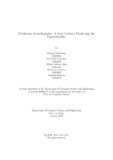| dc.contributor.advisor | Mostakim, Moin | |
| dc.contributor.advisor | Karim, Dewan Ziaul | |
| dc.contributor.author | Chowdhury, Maheen | |
| dc.contributor.author | Rahaman, Md Abdur | |
| dc.contributor.author | Islam, Tafhim Sadman | |
| dc.contributor.author | Sultana, Rahanuma | |
| dc.contributor.author | Rahman, Anjolika | |
| dc.date.accessioned | 2023-09-24T06:03:54Z | |
| dc.date.available | 2023-09-24T06:03:54Z | |
| dc.date.copyright | 2023 | |
| dc.date.issued | 2023-01 | |
| dc.identifier.other | ID 18201069 | |
| dc.identifier.other | ID 18201093 | |
| dc.identifier.other | ID 18301220 | |
| dc.identifier.other | ID 18201105 | |
| dc.identifier.other | ID 21101347 | |
| dc.identifier.uri | http://hdl.handle.net/10361/21174 | |
| dc.description | This thesis is submitted in partial fulfillment of the requirements for the degree of Bachelor of Science in Computer Science and Engineering, 2023. | en_US |
| dc.description | Cataloged from PDF version of thesis. | |
| dc.description | Includes bibliographical references (pages 48-49). | |
| dc.description.abstract | One of the most catastrophic natural disasters is an earthquake, especially because
they typically occur without warning. It has catastrophic effects on both the econ-
omy of a nation and human life. Our paper is a step towards taking the challenge
and complexity of predicting earthquakes and implies that the research here aims
to make progress in this field. In this paper, we have proposed a hybrid model com-
bining multiple algorithms which analyses already existing datasets. We have done
our work in two steps. Firstly, we trained our model on multiple algorithms such as
KNN, SVM, XGBOOST and ADABOOST. Then we created a hybrid model out of
these algorithms which gave us the best results in terms of accuracy and precision.
The use of machine learning techniques for earthquake prediction is examined in
this thesis. We concentrate on the use of multiple algorithms: k-Nearest Neighbors
(KNN), AdaBoost, and Support Vector Machines (SVM). We start by going over
the state of earthquake forecasting right now and how machine learning is applied in
this area. We next go over our study, which involves feeding our models input fea-
tures made up of both seismological and geodetic data. We assess each algorithm’s
performance using a range of evaluation indicators and contrast the outcomes with
conventional statistical techniques. We explore the significance of our results for
future research in this field and show how these machine learning techniques have
the potential to be used to forecast earthquakes. Overall, this thesis makes a posi-
tive contribution to the current work to increase the precision and dependability of
earthquake prediction utilizing cutting-edge machine learning methods. | en_US |
| dc.description.statementofresponsibility | Maheen Chowdhury | |
| dc.description.statementofresponsibility | Md Abdur Rahaman | |
| dc.description.statementofresponsibility | Tafhim Sadman Islam | |
| dc.description.statementofresponsibility | Rahanuma Sultana | |
| dc.description.statementofresponsibility | Anjolika Rahman | |
| dc.format.extent | 49 pages | |
| dc.language.iso | en | en_US |
| dc.publisher | Brac University | en_US |
| dc.rights | Brac University theses are protected by copyright. They may be viewed from this source for any purpose, but reproduction or distribution in any format is prohibited without written permission. | |
| dc.subject | Earthquake | en_US |
| dc.subject | K-Nearest Neighbors(KNN) | en_US |
| dc.subject | Support Vector Machine(SVM) | en_US |
| dc.subject | Extreme gradient Boosting(XGBOOST) | en_US |
| dc.subject | Adaptive boosting(ADABOOST) | en_US |
| dc.subject | Prediction/forecasting | en_US |
| dc.subject.lcsh | Machine learning | |
| dc.title | Prediction of earthquakes: a step towards predicting the unpredictable | en_US |
| dc.type | Thesis | en_US |
| dc.contributor.department | Department of Computer Science and Engineering, Brac University | |
| dc.description.degree | B. Computer Science and Engineering | |

